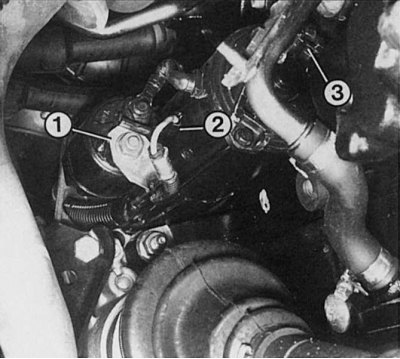The serviceability of the starter can only be checked in the removed state. The starter also needs to be removed to replace the brushes or to check the magnetic switch. Before you disconnect the electrical connections shown in the figure (1 - main electrical wire; 2 - magnetic switch wire), disconnect the wires from the battery ground, otherwise dangerous sparks may occur when the above cables are disconnected.

1. Disconnect the ground wire from the battery terminal. Raise the car at the front and secure.
2. Tag the main electrical wire and disconnect it from the starter.
3. Disconnect the wire (tag) from the magnetic switch.
4. Unscrew the holders of the starter wires.
5. Engine type «WITH»: if present, remove the thermal protection plate.
6. Unscrew the starter mount (3 bolts), while marking the location of the centering sleeve.
7. If installed, remove the starter rear support.
8. Remove a starter from the engine and take out under the car from a motor compartment.
9. Engine type «F»: remove the air filter housing.
10. Unscrew 3 bolts of fastening of a starter. In doing so, mark the location of the centering sleeve.
11. Remove the starter cover (if installed).
12. Remove a back support of a starter.
13. Take out a starter from below from a motor compartment.
14. 16 valve engine: remove the thermal protection of the exhaust (2 bolts).
15. Unscrew 3 bolts of fastening of a starter. In doing so, mark the location of the centering sleeve.
16. Remove the right front wheel.
17. Remove the muffler exhaust manifold reinforcement from the engine housing (2 bolts).
18. Remove the starter rear support (3 bolts) and remove the starter from the engine.
19. Remove the starter from the engine compartment on the right side above the steering linkage linkage.
Removing the magnetic switch
A damaged starter magnetic switch must not be disassembled, it must be replaced as a whole.
1. Remove the starter and clamp it in a vise with protective cheeks.
2. Depending on the type of starter, loosen 2 and respectively 3 bolts in the flange of the starter magnetic switch.
3. Unscrew the electrical connection to the starter and unhook the magnetic switch rod from the starting fork.
4. Remove the magnetic switch from the starter.
5. Lubricate the eye of the magnetic switch rod with high temperature grease when assembling (e.g. Liqui Moly 320) and attach to the launcher.
6. Ensure that the return spring is in the correct position, and then reinstall the magnetic switch housing and tighten it with bolts.
Replacement of starter brushes
If the starter refuses to work, then perhaps the brushes are just jammed (if they are not worn down to the minimum size). To replace, you will need a powerful soldering iron of at least 150 watts. If you do not have one, then you need to contact a car repair shop with a car electrician, while removing and installing the starter yourself. There, your starter will also be checked for mechanical and electrical faults.
1. Remove the starter.
2. Depending on the type of starter, removing the manifold shield (spacer bolt) carried out in different ways.
3. After removing the collector shield, disconnect the carbon brush wire from the holder.
4. Remove the carbon brushes with pressure springs from the holder guides.
5. If necessary, clean the brushes and guides with a cloth soaked in gasoline.
6. Check the carbon pads for wear. If they are ground down to their minimum length of 7 mm or less, they must be replaced as a set.
7. Depending on the type of starter, new brushes (anyway four) must either be screwed or soldered to the wire of the old brushes. To do this, cut the wire of the old brush in the middle between the connection point and the carbon brush.
8. Strip the free end of the copper wire and make sure that the new connection is well soldered and does not form a thickening on the wire when soldering and it does not harden, press the new brush as tightly as possible to the soldering point.
9. Before assembly, check that the carbon brushes are not stuck in their guides on the brush holders.
Starter repair
If signs of wear are strongly pronounced on the removed starter, for example, a strongly retracted collector, burn marks or armature plates cling to the housing, then the armature bearings are badly broken, or the stator winding in the housing has become unusable.
A starter worn out in this way should not be repaired on its own - it is best to leave it to specialists (Bosch) or buy a new one.
